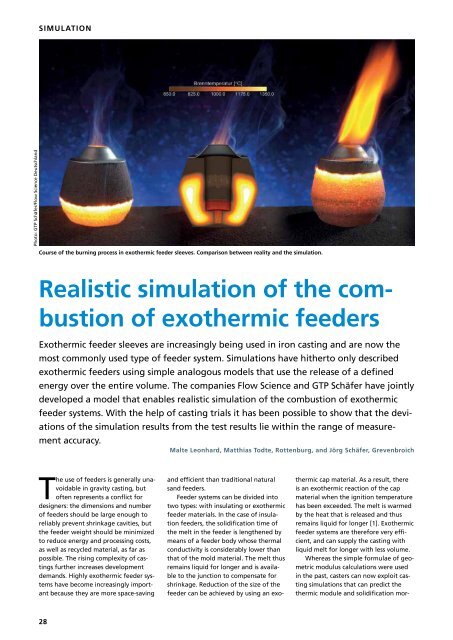CPT International 02/2019
- No tags were found...
You also want an ePaper? Increase the reach of your titles
YUMPU automatically turns print PDFs into web optimized ePapers that Google loves.
SIMULATION<br />
Photo: GTP Schäfer/Flow Science Deutschland<br />
Course of the burning process in exothermic feeder sleeves. Comparison between reality and the simulation.<br />
Realistic simulation of the combustion<br />
of exothermic feeders<br />
Exothermic feeder sleeves are increasingly being used in iron casting and are now the<br />
most commonly used type of feeder system. Simulations have hitherto only described<br />
exothermic feeders using simple analogous models that use the release of a defined<br />
energy over the entire volume. The companies Flow Science and GTP Schäfer have jointly<br />
developed a model that enables realistic simulation of the combustion of exothermic<br />
feeder systems. With the help of casting trials it has been possible to show that the deviations<br />
of the simulation results from the test results lie within the range of measurement<br />
accuracy.<br />
Malte Leonhard, Matthias Todte, Rottenburg, and Jörg Schäfer, Grevenbroich<br />
The use of feeders is generally unavoidable<br />
in gravity casting, but<br />
often represents a conflict for<br />
designers: the dimensions and number<br />
of feeders should be large enough to<br />
reliably prevent shrinkage cavities, but<br />
the feeder weight should be minimized<br />
to reduce energy and processing costs,<br />
as well as recycled material, as far as<br />
possible. The rising complexity of castings<br />
further increases development<br />
demands. Highly exothermic feeder systems<br />
have become increasingly important<br />
because they are more space-saving<br />
and efficient than traditional natural<br />
sand feeders.<br />
Feeder systems can be divided into<br />
two types: with insulating or exothermic<br />
feeder materials. In the case of insulation<br />
feeders, the solidification time of<br />
the melt in the feeder is lengthened by<br />
means of a feeder body whose thermal<br />
conductivity is considerably lower than<br />
that of the mold material. The melt thus<br />
remains liquid for longer and is available<br />
to the junction to compensate for<br />
shrinkage. Reduction of the size of the<br />
feeder can be achieved by using an exothermic<br />
cap material. As a result, there<br />
is an exothermic reaction of the cap<br />
material when the ignition temperature<br />
has been exceeded. The melt is warmed<br />
by the heat that is released and thus<br />
remains liquid for longer [1]. Exothermic<br />
feeder systems are therefore very efficient,<br />
and can supply the casting with<br />
liquid melt for longer with less volume.<br />
Whereas the simple formulae of geometric<br />
modulus calculations were used<br />
in the past, casters can now exploit casting<br />
simulations that can predict the<br />
thermic module and solidification mor-<br />
28

















